
25 minute read
Kyuyong Shin, Hochan Lee, and Junhyuk Oh
Introduction to the Extended Reality-based LVCG Military Training System for Small Units at Korea Military Academy
Kyuyong Shin, Hochan Lee, and Junhyuk Oh
Advertisement
Abstract: Recently, the development and application of military training systems using extended reality (XR) technologies began expanding, thus forming a live, virtual, constructive, and game (LVCG) environment using virtual reality (VR), augmented reality (AR), and mixed reality (MR) concurrently. XR enables new experiences through the fusion of real and virtual worlds. Therefore, if this technology is applied to military training, the new training system will lower the safety risks arising from the field training, reduce training costs dramatically, and allow trainees to experience various combat situations while overcoming physical constraints. Since XR enables low-cost and high-efficiency military training, the development and use of XR-based military training simulators are expected to continue to develop. With this trend, Korea Military Academy (KMA) recently formed a consortium that is funded by the Korea Ministry of Science and Information, Communication, Technology (MSIT) and developed three small-unit LVCG military training simulators: MR-based Medium-range Assault Rifles-shooting Simulator (MARS 300), VR-based Tactical Assault-shooting Drill-simulator (TAD), and AR-based Command and Control (C2) Simulator (Horus Eye). KMA plans to build an XR-based small-unit LVCG military training site composed of MARS, TAD, and Horus Eye by the end of 2021. This system will allow one platoon to form three teams of ten to train on precision shooting, small-unit combat skills, and C2 exercises, respectively at the same time. The small-unit LVCG training site is expected to make a remarkable contribution to improve the mastery of small-unit combat skills for KMA cadets and Republic of Korea (ROK) Army soldiers in the future.
Keywords: LVCG, Extended Reality (XR); Military Training Simulator; Medium-range Assault Rifles-shooting Simulator (MARS); Tactical Assault-shooting Drill-simulator (TAD); Command and Control (C2) Simulator (Horus Eye); Small-Unit Combat Skills.
Introduction
XR (Extended Reality) is a terminology involving all real and virtual environments where reality and virtuality interact. It refers to an overarching set of hyper-realistic technologies and services to include virtual reality (VR), augmented reality (AR), and mixed reality (MR).1 In the past, XR technology was mainly applied to entertainment—Pokémon GO as an example—but recently it has been widely used in various fields such as manufacturing, education, medical, operations, and national defense.2
Trending along the field of national defense, XR-based combat training platform development and usage are particularly noticeable. XR-based combat training platform has advantages: It enhances training outcomes through the use of realistic virtual space; and it also significantly reduces costs and risks associated with training.3 Especially, the XR-based platform is gaining status as a certain replacement to the conventional means for military
and/or counter-terror training that have high costs and risks.4 The XR-based combat training platform, which includes VR-based precision shooting range, AR-based command and control (C2) system, AR-based maintenance training system, and AR-based counter-terror training system, has been consistently expanding its application5. In particular, VBS and DSTS, are the most famous XR-based LVCG simulators which train marksmanship and situation response for small units.6
Following this trend, KMA recently formed a consortium with firms that held XR-related technologies since 2017 with aid from MSIT and developed MR precision shooting training system (MARS 300), VR combat skill training system (TAD), and AR Command and Control (C2) platform (Horus Eye). First, MR-based MARS 300 applies various technologies to allow users to experience precision shooting and engagement in an MR environment. Next, Head Mounted Display (HMD)-based TAD incorporates new technologies which allows individual combatants to train for various small-unit combat skills in virtual reality spaces. Finally, but not least importantly, AR-based Horus Eye employs technologies to enable effective training of AR-based command post exercise (CPX) and support efficient and successful mission accomplishment based on accurate situation awareness.
KMA is building a small-unit training site equipped with MARS 300, TAD, and Horus Eye. Once the training site is built, a platoon can train in teams of ten for precision shooting, smallunit combat skills, and CPX-incorporated C2 exercises. Small-unit training system is expected to contribute to improve combat skills of all KMA personnel including cadets.
MR-Based Precision Shooting System: MARS 300
The first of the KMA LVCG training systems is MR-based MARS 300 (Figure 1). MARS 300 is composed of projection screens to allow precise shooting training through realistic sight alignment for the users. For such experience, the system is supported by (1) synchronization of real and virtual spaces; (2) real-time sight and bore alignment; (3) application of various ballistics; and (4) haptic-based real-time hit sensing suit, which are all discussed in detail hereafter.
Figure 1. Prototype of MARS 300.
Synchronization of real and virtual spaces. MARS 300 is made as a screen-based simulator for precision shooting. Accordingly, it requires the virtual space on the screen and reality space to be precisely synchronized to translate the trainee’s position/ actions and shooting experience in a more realistic fashion. However, conventional screen-based shooting simulators mostly did not synchronize reality and virtual spaces. If the training system fails to synchronize spaces,
just as we know from simulation shooting game arcades, it leads users to aim at the same spot (upper-left in Figure 2) regardless of the position of the shooters.
Figure 2. Synchronization of Spaces as User’s Positions Change.
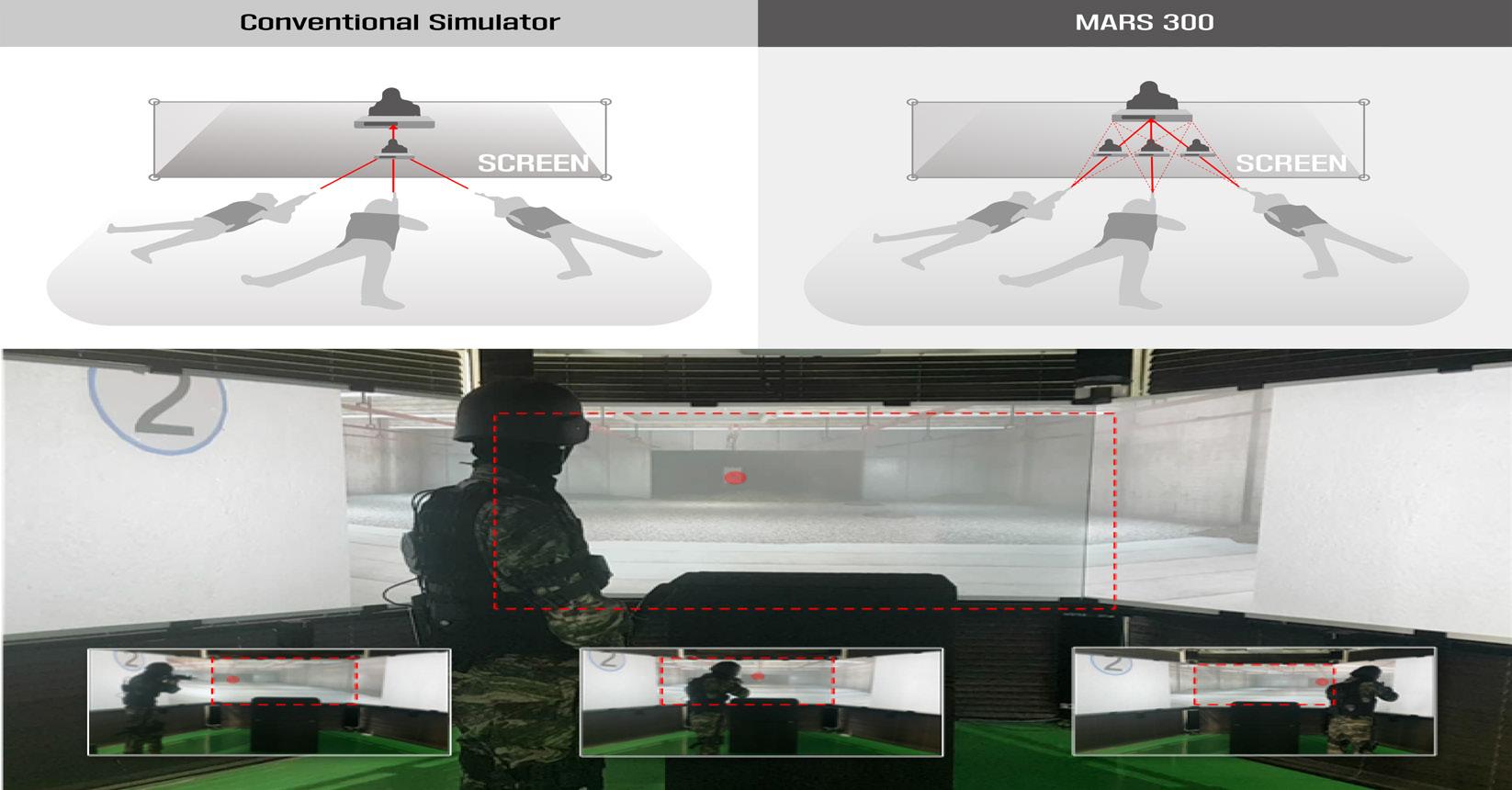
But if the system is synchronized it makes users aim at different points on the screen as users change their positions (upper-right in Figure 2). MARS 300 uses information from the sensor device on the helmet to recognize the exact location of the trainee and synchronize reality and virtual space so that it changes the trainee’s perspective on the screen as the trainee changes positions. Additionally, depending on each trainee’s position, the virtual space distance between the trainee and the target varies and also ballistics change. Therefore, the trainee needs to adjust aiming to accommodate the associated change on the target for varied positions and distance in MARS 300.
Tracking of sight and bore alignment. Sight alignment and picturing is achieved through shooter’s alignment of front, rear sight and his/her eyesight plus placing such alignment on the target. Presuming that the round flies on a straight line, the line of bore is the same as the flight path of the round and thus making it important to align sights. As for MARS 300, specially designed sensors are attached to the firearm (M16A1 or K2) and are able to measure the direction of aim in the 3D space and, thanks to the space synchronization technology, they can accurately recognize the shooter’s position. Therefore, once the shooter aligns the sight and correctly pictures the target, the bore is accurately directed toward the target. That is, the mentioned space synchronization technology accurately recognizes the shooter’s position, and based on the information from the sensors on the firearm, the system precisely acquires the firearm’s location and direction thus realistically enabling the user to train on real-life sight aligning and picturing. Through this process, near-real training environment is simulated in MARS 300.
Figure 3. Line of Sight vs Line of Bore.

Application of various ballistics. Generally when the line of bore is parallel to the ground, the bullet departing from the muzzle drops as the Earth’s gravity pulls it down. That is, when there is no air influence, the bullet does not move horizontally but does vertically downward, thus making a horizontal projectile motion as in Figure 3. Accordingly, when aligning the line of sight with the line of bore, the farther the distance between the target and the muzzle, the lower the bullet on the target. Therefore, the line of bore is designed to be intersecting upward with the line of sight. From this intersection, the departed bullet travels upward from the muzzle and forms a trajectory that intersects with the line of sight twice as seen in the Figure 3.
Because MARS 300 applies precision ballistics curve, calculated from fluid mechanics equations, of K100 and K193 rounds used for M16A1 and K2 rifles, it can calculate accurate shot placements on targets and these results are certified by PRODAS database (http://www.prodas. com/xq/asp/p.400/qx/webpagexml4.htm). So far only the ballistics of M16A1 and K2 rounds are applied to MARS 300 but by this year’s end, the system will expand to include various platoon-level weapon systems through additional research.
Haptic-based real-time hit sensing suit. Just like shooting arcades, the enemy in the MARS 300 screen also shoots back at the trainee and simulates the damage on the trainee. But MARS 300 distinguishes itself from those gaming arcades in that for one, the enemy’s bullet incorporates realistic ballistics, and for the other, if there is another object on the ballistic curve between the shooter and the target, the bullet does not travel through it, failing to incur damage on the target.* Therefore, if trainees do not fully cover themselves, they can be hit. To make the training realistic, the bullet fired from the enemy in the virtual space must be recognized or experienced by the trainee. To do this, MARS 300 trainees equip haptic-based real-time hit sensing suit to experience the hit caused by the enemy. (*It will be explained later in the following section but the enemy on the screen exists to simulate the other user on the network.
All users look at the screen in his own perspective just like in the real combat, facing the other opponent user as the enemy on the screen.)
The haptic-based real-time hit sensing suit is composed of nine RF sensors as seen in the Figure 4. These nine RF sensors notify the trainee which part of the body is hit by vibrations and LED lights, depending on whether the sensor in question is on the ballistic curve of the virtual enemy’s bullet. Also, the damage on the hit body part is transmitted to the evaluation system and updated real-time, disabling the user’s shooting in case the damage is critical.
Figure 4. Haptic-based Real-time Hit Sensing Suit.

Network-based cooperation and mutual engagement. While an individual simulator that accommodates a single user in one unit to enable space synchronization, MARS 300 can be expanded to simulate simultaneous cooperation with multiple users as well. As seen in Figure 5, a single trainee enters a training booth that creates a virtual space with virtual enemies for engagement. If multiple training booths are connected through the network and thus share the virtual space among other trainees, a coordinated training with multiple users is possible. In that case, other users in the virtual space are described as enemies or friendly avatars on the screen.
Figure 5. Haptic Engagement in Place with Enemies.
Other characteristics of MARS 300. In addition to the mentioned technologies, MARS
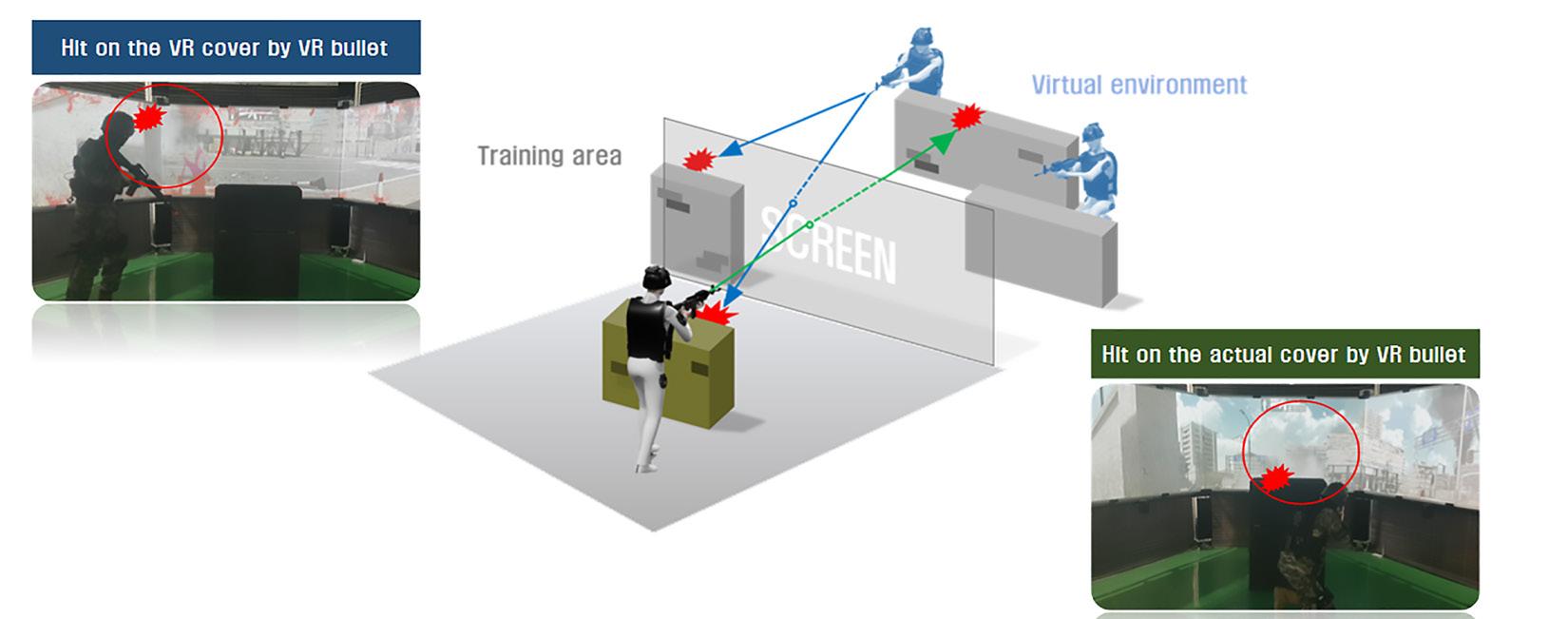
300 has various firearms developed for use, each able to emulate recoil using gas-operated mechanism for realistic shooting experience. Also, because it uses space synchronization and precision ballistics, it has the potential to be used for various training purposes to include sniper and artillery fire observer training. Currently MARS 300 is being used for various training such as Basic Rifle Marksmanship (BRM), Advanced Rifle Marksmanship (ARM), and Close Quarters Battle (CQB).
VR-Based Small-unit Combat Skill Training System: TAD
MARS 300 is a precision shooting simulator and, therefore, it is a screen-based platform to allow naked eye sight alignment. However, most close quarter combats require combatants to conduct pointed shooting instead of aimed shooting. Therefore, when precise shooting is not required, using a VR-based simulator is effective. TAD accomplishes these requirements. TAD uses (1) a hyper-realistic immersive training environment; (2) motion detection-based behavior synchronization; (3) specially designed safety bar for the freedom of movement; and (4) a terrain recognizing motion platform. With these technologies the system enables trainees to master small-unit combat skills. Figure 6 illustrates its prototype.
Figure 6. Prototype of TAD.

Hyper-realistic immersive training environment. Because TAD training contents are simulated on the HMD device, it provides much more immersive experience than MARS 300. This is because the VR technology offers much higher level of immersion through the HMD device than the screen-based MR technology in MARS 300. Accordingly, trainees who use TAD for training may situate themselves in a near-actual operational environment. TAD simulators are composed of basic training scenarios for infantry combatants at the small-unit level including reconnaissance in General Out Post (GOP), coastline defense and reconnaissance, CQB in urban terrain, and room clearing. Currently the training site in construction is expected to provide trainees with more scenarios for their realistic training experience.
Motion detection-based action synchronization. Figure 7 shows six sensors attached to a trainee that detect his motions in reality and translate them to motions in the virtual space. When initiating the TAD simulator training, after synchronizing sensors, the avatar in the
virtual space reacts to the user’s actions and emulates the same actions in the virtual space. Motion information collected from six motion sensors is reflected in the avatar’s motions in the virtual space in real-time. Such action synchronization allows trainees to express all the tactical actions such as marching, double-timing, kneeling, and prone positions just like actual battlefield.
Figure 7. Behavior Synchronization of Trainee and Avatar.
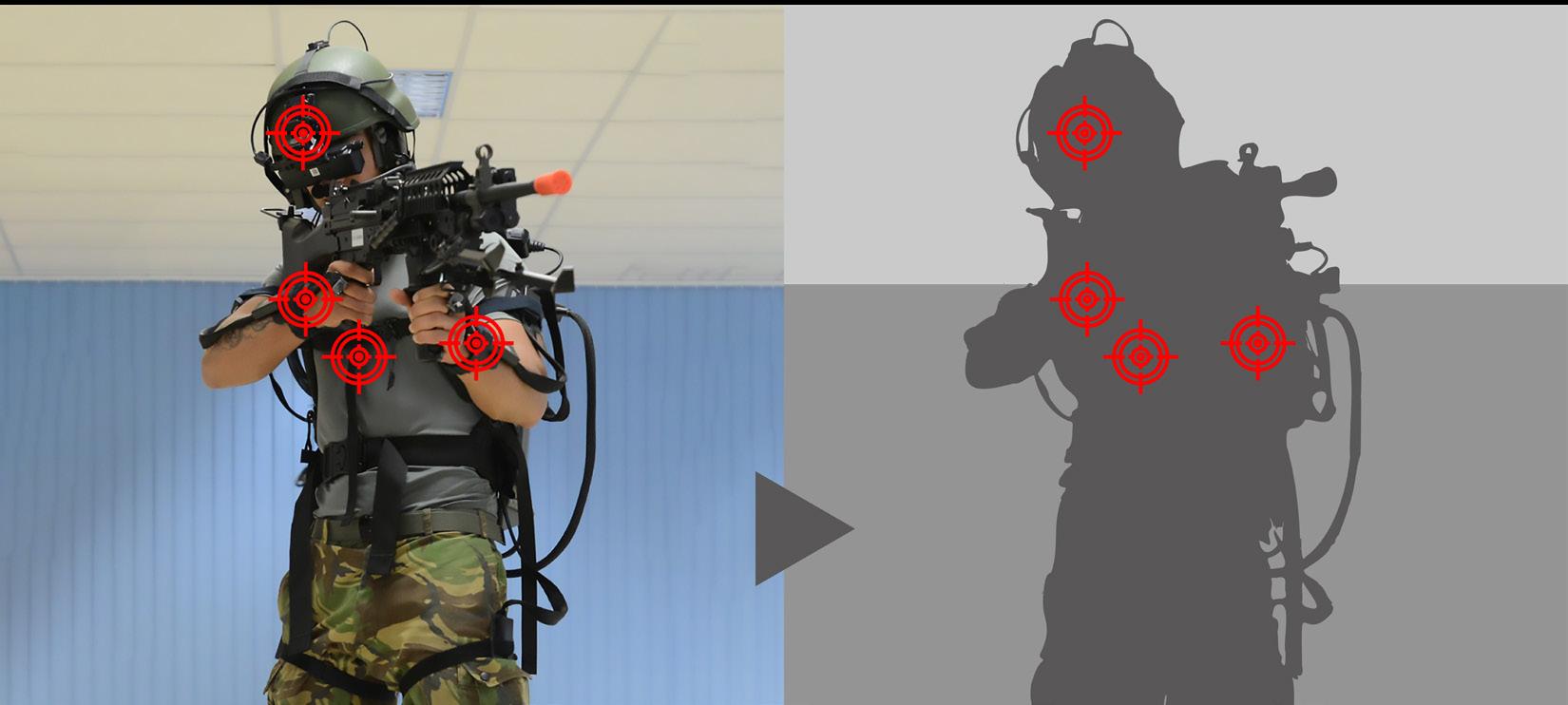
Specially-designed safety bar for freedom of movement. Figure 8 shows a conventional treadmill-based VR simulator where trainees are locked up by the waist to limit their movement for safety reasons when they are fully immersed through the HMD device. This is a necessary measure for preventing safety hazards because while wearing the HMD device, trainees cannot perceive the real space. However, although such a physical restrictive measure may prevent injuries, because it limits their movement significantly, trainees are also limited from taking various tactical actions. As seen in Figure 9, the TAD simulator guarantees the safety of trainees while allowing them the best possible freedom of movement by the specially-designed safety bar. The safety bar for TAD allows trainees to take various tactical actions with such freedom that was not possible in the conventional waist-fixing platform, enabling trainees to train their combat skill in a much more realistic manner.
Figure 8. Waist Fixation. Figure 9. TAD Safety Bar.
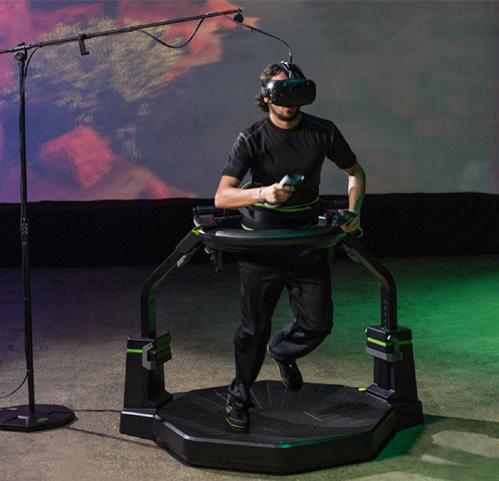
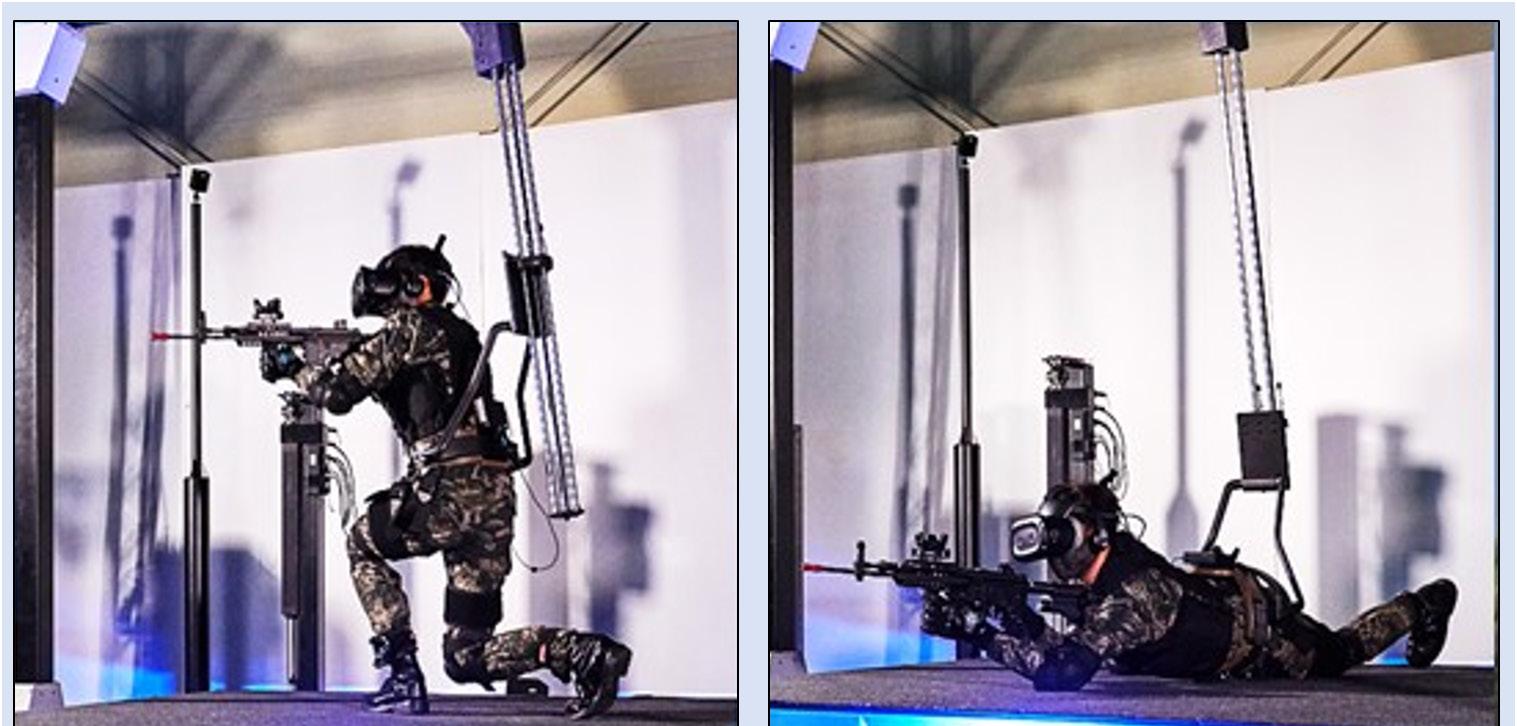
Terrain recognizing motion platform. The terrain recognizing platform in TAD synchronizes with the virtual space terrain simulated on the HMD and allows trainees to experience the physical gradient changes as the terrain in the virtual space changes. That is, TAD terrain recognition motion platform emulates the virtual downhill slope in reality and vice versa as seen in the Figure 10.
Figure 10. Terrain Recognizing Motion Platform.
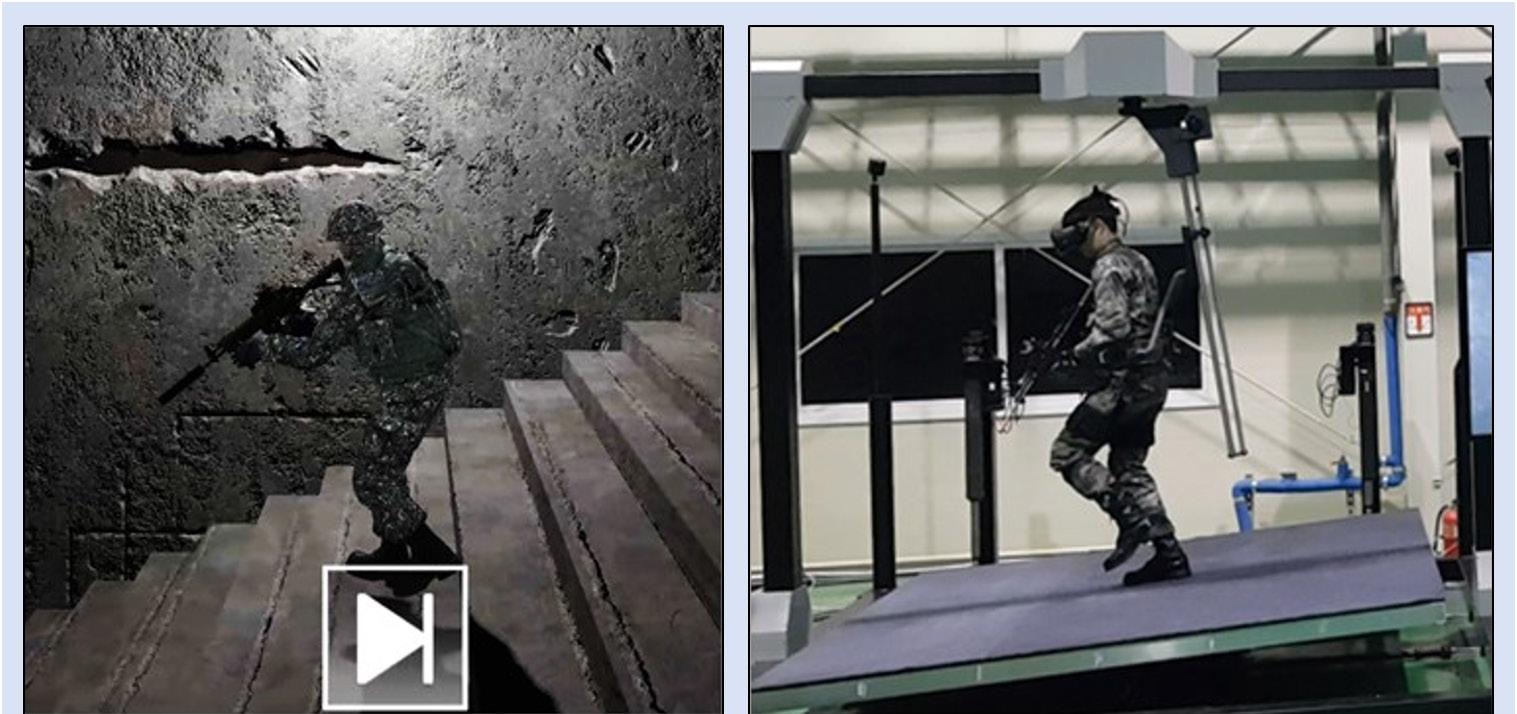
The terrain recognizing motion platform not only offers gradient experience but also shaking in battlefield. When shell rounds are landed in the virtual space, the platform shakes the surface with sound effects so that those trainees around the shell may experience a similar feeling as being on the battlefield. In sum, the terrain recognizing motion platform offers various battlefield effects including gradient change as well as sensory effects through the HMD device so that trainees are able to experience more realistic training.
AR-Based Command and Control System: Horus Eye
The 5G-based AR integrated command and control (C2) platform, named Horus Eye, uses a commercial 5G network to conduct a real-time aggregation of various information in the battlefield including the terrain and weather of the area of operation (AO) and the intelligence on the friendly and enemy forces at the C2 center. C2 room supports soldiers by producing 2D and 3D Common Operational Pictures (COPs) based on the information from the AO through the AR technology and sharing them with individual combatants in the AO so that everyone may execute operations efficiently and effectively under common and accurate situational awareness (SA). Horus Eye is composed of the field of operation, C2 room, and the commercial 5G network as shown in the Figure 11.
Figure 11. Horus Eye Concepts.
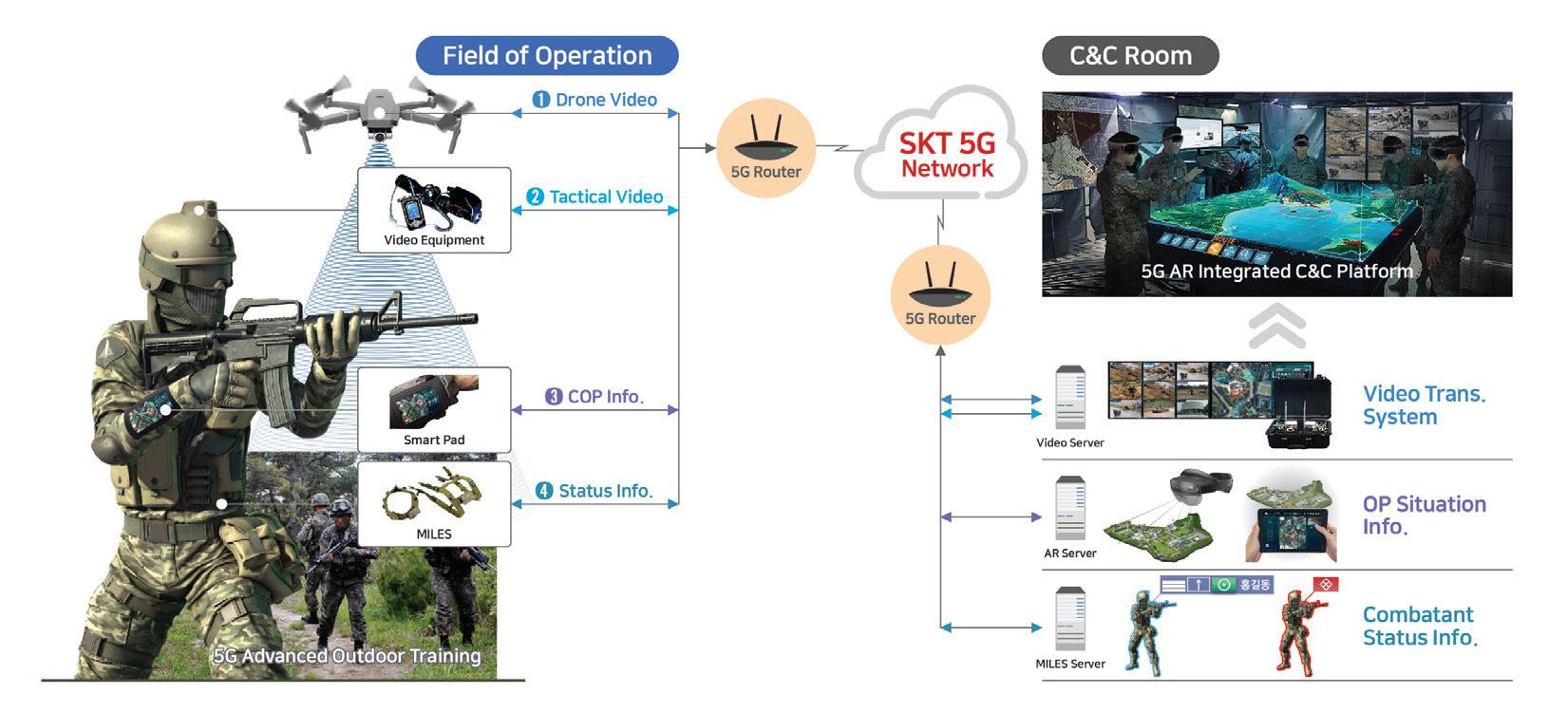
Field of Operations. Combatants in the field of operations are equipped with the following four devices: 1) Multiple Integrated Laser Engagement System (MILES) device for describing individual damage from engagements during training, 2) a camera that obtains visual information of the AO from individual perspective, 3) a smart pad that reports the situation back to the C2 room or displays COP transmitted from the C2 room, and 4) a 5G router that transmits the information from the above three devices. In addition, in the air of the AO, drones are employed to acquire visual information across the entire AO to transmit it to the C2 room. All visual information and data are transmitted in real-time through the commercial 5G network after encrypted from a cryptographic module certified by the Korea Cryptographic Module Validation Program (KCMVP) of the National Intelligence Service (NIS) of Republic of Korea.
Command and Control Room. Commanders (or leaders) orient themselves in the Horus Eye C2 room based on drone visual intelligence, individual combatants’ visual intelligence, engagement damage assessment received from MILES devices, and reports from individual soldiers, and make command actions immediately. Accordingly, the C2 room requires display devices such as 1) 9-segment on-site video display monitor which shows the positions of drones and individual combatants, 2) 2D COP monitor which shows friendly and enemy forces, and 3) AR-based 3D COP that expresses 3D terrain and friendly and enemy forces dispositions with the help of Microsoft HoloLens 2, which shows transmitted information from the AO in realtime.
High-quality videos filmed by the combatants and drones in the AO are transmitted through 5G network to be displayed on the C2 room’s 9-segment monitor in real-time as shown in the Figure 12. Through this visual intelligence relayed from the AO in real-time, commanders at the C2 room can check the intelligence of the battlefield as if he is at the scene. Also, the MILES
information from individual soldiers returns their real-time status and positions to the 2D COP monitor in the C2 room as shown in the Figure 13.
Figure 12. 9-segment On-site Video Display Monitor.
Figure 13. The 2D Common Operational Picture.


Additionally, the C2 room transmits back the 2D COP shown in the Figure 13 through the 5G network after aggregating all the intelligence from the AO regarding additional information on the enemy and friendly, such as enemy position and size. The 2D COP transmitted in this way is also going to be shown on the combatants’ smart pad in the AO thus allowing their common SA for executing their operation.
Figure 14. The Microsoft HoloLens 2-based 3D Operational Picture.
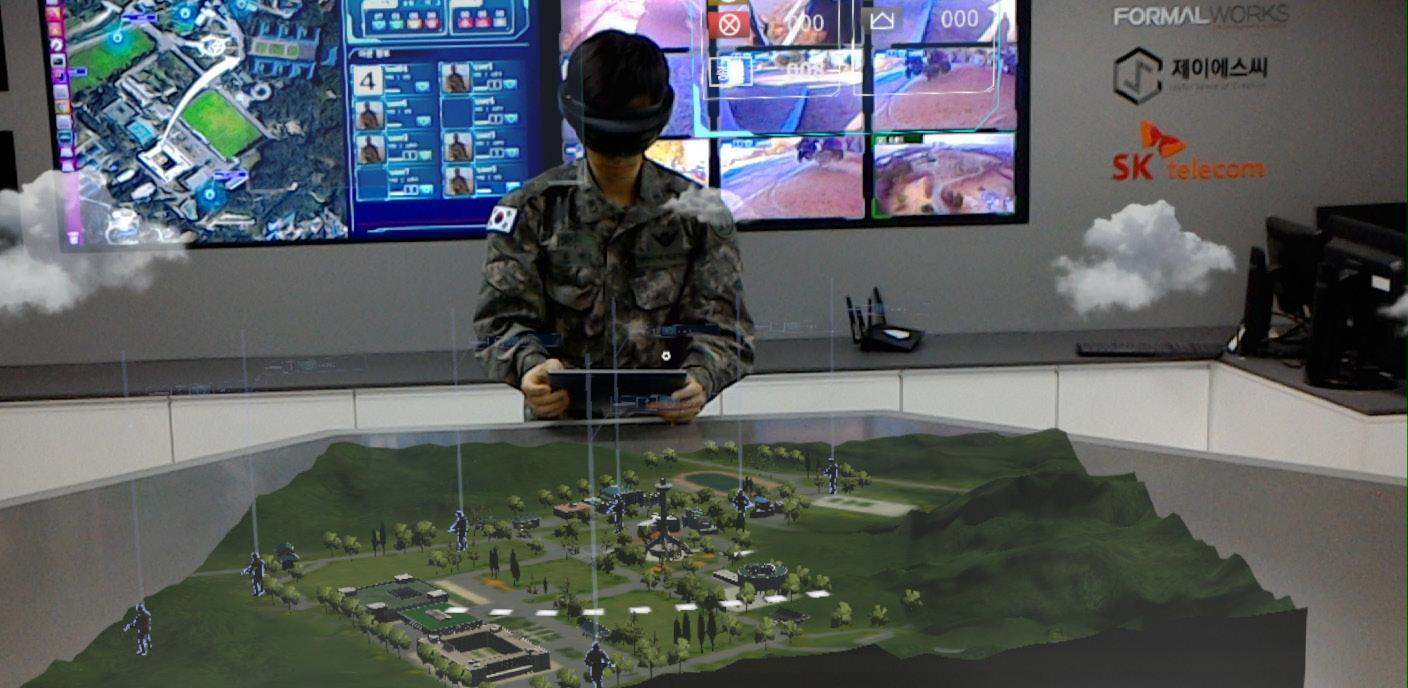
The most notable characteristic of Horus Eye is the Microsoft HoloLens 2-based AR 3D COP developed by the KMA-led consortium research team7, which is shown in the Figure 14. Horus Eye’s AR COP creates a 3D topographic map of the desired AO based on the digital terrain information and visualizes a detailed 3D COP for multiple commanders’ visual aid integrated with additional intelligence on the terrain. Furthermore, using tablet PC-based interface Horus Eye can easily input and output various information such as the disposition of friendly and enemy forces, unit movement routes, effective range for firearms, contour lines and grid lines, etc. Because the AR 3D COP can describe the AO in a more detailed and realistic ways than the 2D COP, it helps commanders (or leaders) at the C2 room to make effective decisions through quicker and accurate orientation of the operational environment. Horus Eye’s AR 3D COP may be used for mission briefing, operation order (OPORD) briefing, and war gaming in the operation planning phase, and it can be used as an effective tool for the successful C2 through real-time intelligence updates during the operation execution phase.
5G Networks. To ensure the workable operating environment of Horus Eye, the real-time transmission of large-scale data between the AO and C2 room is guaranteed without delay. To do this, a network platform between the AO and C2 room that allows high-speed, low-latency, large-scale data transmission is essential. In April 2019, KMA collaborated with SKT, one of the preeminent telecom firms, to build a commercial 5G network running throughout KMA and developed Horus Eye on top of the network. When transmitting training related information on the commercial network platform, cryptographic modules certified by KCMVP were used on the 5G router to reinforce security measures. That is, all the data sent to the C2 room from the AO was encrypted with the KCMPV-certified cryptographic modules before the transmission and they are decrypted with the module to be used. The same is applied to the data send from the C2 room to the AO as well.
Small-Unit LVCG System Pilot Program
MARS 300, TAD, Horus Eye are all systems developed by a KMA-led consortium funded by the MSIT. As of April 2021, KMA is building a small-unit LVCG training system mainly consisting of MARS 300, TAD, and Horus Eye with a funding of 7.5 billion won (6.7 million US dollars) by the Ministry of Defense. Therefore, this LVCG training system will offer training experience in precision shooting, small-unit combat skills, and CPX-enhanced C2 for a platoonsized unit simultaneously. In this section, additional research and development, training site construction plan, and future use and application for the LVCG training site will be discussed.
Additional Research and Development. As mentioned, the KMA-led and MSIT-funded consortium developed MARS 300, TAD, and Horus Eye. These took two years to develop into simulators tailored to small-units and have shown significant technological achievement but a few limitations exist in directly fielding these simulators for operational forces.
First, because the time used for developing these simulators was relatively short, only Republic of Korea’s most-used rounds, 5.56mm caliber M193 and K100, for M16A1 and K2 rifles, are simulated. But since Korea’s military uses various small-unit weapon systems (such as K1 rifle, K3 machine gun, K201 grenade launcher, K5 pistol, and K12 multi-purpose machine gun), MARS 300 and TAD will incorporate other platoon-level weapons to effectively simulate squad/team-level force-on-force or precise shooting training. Currently research and development is underway to add selections of five weapon systems and their ballistic curves in the system, in addition to M16A1 and K2 rifles.
Second, MARS 300, TAD, and Horus Eye have limited training contents due to the short duration for the training system development. Therefore, for this pilot small-unit LVCG training initiative, various standardized training contents are being developed that are suited for diverse combat situations to include warfare in mountain, urban terrain, and coastal terrain. These standardized training contents are planned to be developed to simulate training under various weather and operational environments of the Korean peninsula where three sides are surrounded by water. Specifically, those contents will coordinate environmental variables to be reflective of Korea’s definite four seasons, weather and climate conditions, and daytime/ nighttime operational environment, as well as building virtual training site that can simulate realistic terrain of Korea.
Third, there is not an evaluation system on the training by MARS 300, TAD, and Horus Eye. In the small-unit LVCG training, feedback through standardized training assessments is as important as the training itself. Therefore, training analysis and assessment system development are still underway to allow a series of processes from building a real-time database of trainees’ performance and the status during training to using it for after-action review to analyze and discuss matters related to shooting accuracy, battle damage, and tactical action choices and so on. The purpose of the pilot program is to evaluate the efficiency of MARS 300, TAD, and Horus Eye simulators and make additional adjustments based on the collected and assessed results for the future expanded use in the field.
Training Site Construction Plan. The LVCG training site on KMA being under construction is a two-story building in the size of 950.40m2(~10,230ft2), with one set of Horus Eye and 10 sets of TAD on the first floor and one set of Horus Eye* and 10 sets of MARS 300 on the second floor. *One set of Horus Eye is composed of 10 Microsoft HoloLense 2 and, therefore, 10 personnel can simultaneously conduct order briefing, war gaming, and C2 training.
Figure 15. TAD Simulator Layout. Figure 16. MARS 300 Simulator Layout.
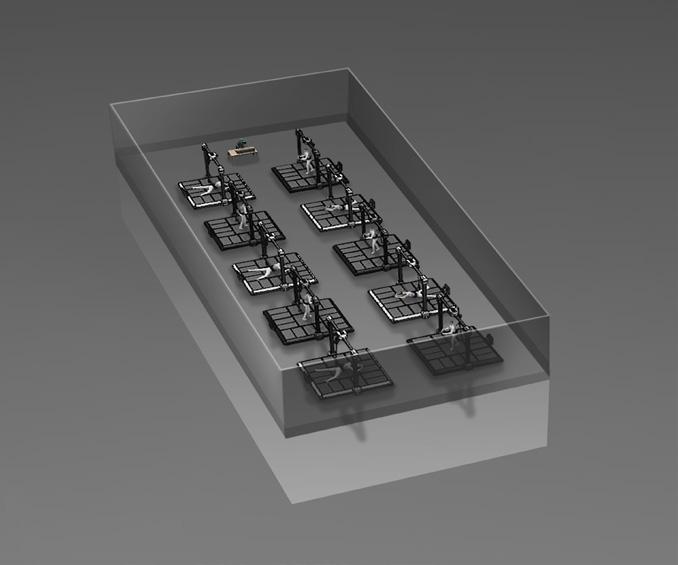
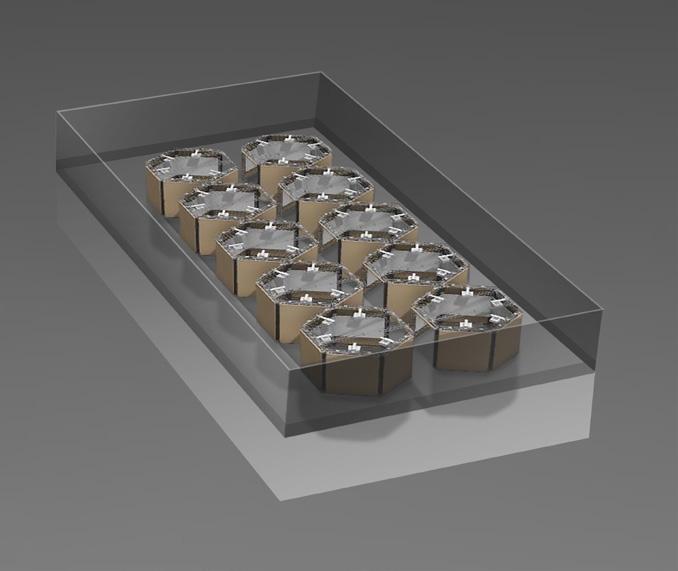
Figure 15 shows the first floor of the training site layout with one set of Horus Eye and 10 sets of TAD. TAD will simulate various training environments to include mountains, urban terrain, coastlines, and room clearing missions. Squad leaders, before they execute operations, may conduct mission briefing, issue orders, and run war-games; once they begin execution C2 personnel may begin C2 training using Horus Eye.
Figure 16 illustrates the second floor layout consisting of 10 sets of MARS 300 and one set of Horus Eye. 10 sets of MARS 300 are synchronized with network for ten squad members to be in the shared virtual space to conduct a coordinated training by sharing virtual training contents. Offered training contents are zeroing, reduced target shooting range, shooting at known distance, and CQB. In particular, CQB is synchronized with Horus Eye and just as TAD is used with Horus Eye, the same activities may be performed before and during the execution of operation through Horus Eye. Specifically, briefing on the mission, issuing orders, conducting war-game before the execution and C2 activities by concerned personnel once the squad is executing operation.
Training Site Utilization and Application to Field Troops. The small-unit LVCG training site under construction will be used during basic training before matriculation, five-week summer military training, and concurrent supplemental training in academic semester days for low-performers and volunteers. Also the facility will be used for soldiers in Service Support Group and other units as a part of training for their basic warrior skills. KMA plans to complete the construction and run pilot programs to analyze training achievement and make necessary adjustments. The ROK Army plans to budget about 40 billion won (35.8 million U.S. dollars) to field the training system in the Army.
Conclusion and Future Plans
This paper introduces the XR-based small-unit LVCG training system that KMA is building on post. This is a government-funded XR-based mock combat system, which is composed of MARS 300, TAD, and Horus Eye. The systems were built by a KMA faculty consortium research team in collaboration with emerging tech firms with related technologies. This system is developed to simulate training at the small-unit (team and squad) level and to achieve training purposes in precision shooting, small-unit combat skills, and CPX-enhanced C2.
The ROK Army highly appreciates this system’s superior value and is running a pilot program in KMA to build, operate, and assess a platoon-level training site so that it will have a standard small-unit LVCG training model for the Army. In the near future, KMA will use this training system for cadets and soldiers on post and develop a standardized assessment system to analyze and assess training results and further improve the training system. Through this effort, KMA will set up and operate high performing small-unit LVCG training systems throughout the Army and contribute to the generation of its combat power.
Kyuyong Shin, Ph.D., is a professor in the Department of Computer Science at Korea Military Academy of South Korea. He received his Ph.D. from North Carolina State University in 2009 and his master’s degree from Korea Advanced Institute of Science and Technology in 2000 respectively. His research interest lies in distributed systems and network security. He can be reached at kyshin@kma.ac.kr or kyuyong.shin@gmail.com.
Hochan Lee, Ph.D., is an associate professor in the Department of Physics at Korea Military Academy of South Korea. He received his Ph.D. in physics from Purdue University in 2013 and his master’s degree from Seoul National University in 2004 respectively. His research interest lies in optics and biophysics. He can be reached at channy64@kma.ac.kr or optichan@gmail.com.
Junhyuk Oh, MILR, is a lecturer in the Department of English at Korea Military Academy of South Korea. He received his MILR from Cornell University in 2020 and his bachelor’s degree from United States Military Academy in 2011. His research interests are innovation in military organizations and related human resource management policies. He can be reached at junhyuk. oh66@gmail.com.
Endnotes
1. Sanika Doolani et.al., “A Review of Extended Reality (XR) Technologies for Manufacturing
Training,” Technologies 2020, 8(4), 77; https://doi.org/10.3390/technologies8040077. 2. Yuliya Shapiunova, “What Is Extended Reality and What Can We Do with It?,” Sam Solutions,
August 24, 2018. https://www.sam-solutions.com/blog/what-is-extended-reality-and-whatcan-we-do-with-it/. 3. Kyuyong Shin and Sehwan Lee, “Developing an XR based Hyper-realistic Counter-
Terrorism, Education, Training, and Evaluation System,” Convergence Security Journal 20, no. 5 (December 2020). 4. Ibid. 5. Byounghwak Lee, Jonghwan Kim, Kyuyoung Shin, Dongwook Kim, Wonwoo Lee, and
Namhyuk Kim, “A study on the actual precision shooting training based on virtual reality,”
Convergence Security Journal 18, no. 4 (October 2018); Kyuyong Shin, Wonwoo Lee, and
Dongwook Kim, “Developing an Augmented Reality-based Integrated Command and
Control Platform under 5G Technologies and Its Applications,” The Journal of Digital
Contents Society 21, no. 5 (May 2020); Jinsuk Kang, Hyunsuk Jung, “Server, method, wearable device for supporting maintenance of military apparatus based on augmented reality, virtual reality or mixed reality”, Patent KR101874461B1, 2018; Myunghwan Park, Sangsoo Lee, Ki
Seok Jeon, and Hyeonju Seol, “A Study on the Development Direction of Education and
Training System based on AR/VR Technology,” Journal of the KIMST 22, no. 4 (201), 545554; Sandeep Dhingra, “Augmented or virtual reality in defence: Revolutionising military missions,” Financial Express, October 21, 2020, https://www.financialexpress.com/defence/ augmented-or-virtual-reality-in-defence-revolutionising-military-missions/2110574/; and
Donghan Kwon, “A Study on Small unit Combat Training Model Based on Virtual Reality,” (Master’s thesis, Chosun University, 2020). 6. Bohemia Interactive Simulations, VBS4, https://bisimulations.com/products/vbs4; Martin L.
Bink, Victor J. Ingurgio, David R. James, and John T. Miller II, “Training Capability Data for Dismounted Soldier Training System,” United States Army Research Institute for the
Behavioral and Social Sciences, June 2015; and Pascual Flores, “Virtual simulators provide realistic training,” Joint Base McGuire-Dix-Lakehurst Public Affairs, March 21, 2013, https://www.jbmdl.jb.mil/News/Article-Display/Article/243602/virtual-simulators-providerealistic-training/. 7. Sangjun Park, Kyuyoung Shin, Dongwook Kim, Tai Hyo Kim, Hyo Bin Roh, and Wonwoo Lee,
“Developing an AR based Command Post eXercise(CPX) Simulator,” Journal of Information and Security 18, no. 5 (December 2018).







